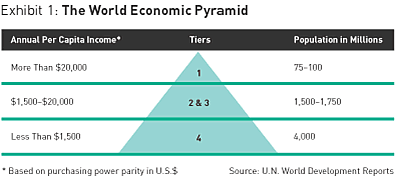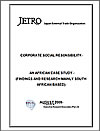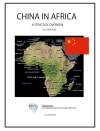BOP Report(Bottom of the Pyramid)
All data are collected in the Fiscal Year of 2008-2009.
3. Four Consumer Tiers
At the very top of the world economic pyramid are 75 to 100 million affluent Tier 1 consumers from around the world. (Exhibit 1.) This is a cosmopolitan group composed of middle- and upper-income people in developed countries and the few rich elites from the developing world. In the middle of the pyramid, in Tiers 2 and 3, are poor customers in developed nations and the rising middle classes in developing countries, the targets of MNCs’ past emerging-market strategies.

Now consider the 4 billion people in Tier 4, at the bottom of the pyramid. Their annual per capita income — based on purchasing power parity in U.S. dollars — is less than $1,500, the minimum considered necessary to sustain a decent life. For well over a billion people — roughly one-sixth of humanity — per capita income is less than $1 per day.
Even more significant, the income gap between rich and poor is growing. According to the United Nations, the richest 20 percent in the world accounted for about 70 percent of total income in 1960. In 2000, that figure reached 85 percent. Over the same period, the fraction of income accruing to the poorest 20 percent in the world fell from 2.3 percent to 1.1 percent.
This extreme inequity of wealth distribution reinforces the view that the poor cannot participate in the global market economy, even though they constitute the majority of the population. In fact, given its vast size, Tier 4 represents a multitrillion-dollar market. According to World Bank projections, the population at the bottom of the pyramid could swell to more than 6 billion people over the next 40 years, because the bulk of the world’s population growth occurs there.
The perception that the bottom of the pyramid is not a viable market also fails to take into account the growing importance of the informal economy among the poorest of the poor, which by some estimates accounts for 40 to 60 percent of all economic activity in developing countries.
Most Tier 4 people live in rural villages, or urban slums and shantytowns, and they usually do not hold legal title or deed to their assets (e.g., dwellings, farms, businesses). They have little or no formal education and are hard to reach via conventional distribution, credit, and communications. The quality and quantity of products and services available in Tier 4 is generally low.
Therefore, much like an iceberg with only its tip in plain view, this massive segment of the global population — along with its massive market opportunities — has remained largely invisible to the corporate sector.
Fortunately, the Tier 4 market is wide open for technological innovation. Among the many possibilities for innovation, MNCs can be leaders in leapfrogging to products that don’t repeat the environmental mistakes of developed countries over the last 50 years. Today’s MNCs evolved in an era of abundant natural resources and thus tended to make products and services that were resource-intensive and excessively polluting. The United States’ 270 million people — only about 4 percent of the world’s population — consume more than 25 percent of the planet’s energy resources. To re-create those types of consumption patterns in developing countries would be disastrous.
We have seen how the disenfranchised in Tier 4 can disrupt the way of life and safety of the rich in Tier 1 — poverty breeds discontent and extremism. Although complete income equality is an ideological pipe dream, the use of commercial development to bring people out of poverty and give them the chance for a better life is critical to the stability and health of the global economy and the continued success of Western MNCs.
目次
- 1. Reperceiving Business from the Bottom Up
- 2. Bop in Brief
- 3. Four Consumer Tiers
- 4. The Invisible Opportunity
- 5. Tier 4 Pioneer
- 6. Creating Buying Power
- 7. Shaping Aspirations
- 8. Improving Access
- 9. Tailoring Local Solutions
- 10. Putting It All Together
- 11. A Common Cause
- 12. BOP Experiments in the Field
- 13. A BOP Typology
- 14. What's Next for BOP?
- 15. How to Get Started: The Conceptual Framework for BOP Innovation
- 16. BoP Conferences
- 17. Case Studies and Relevant Reference Material
- Bibliography




